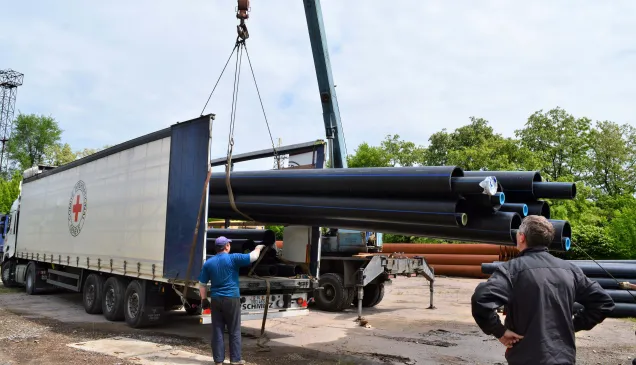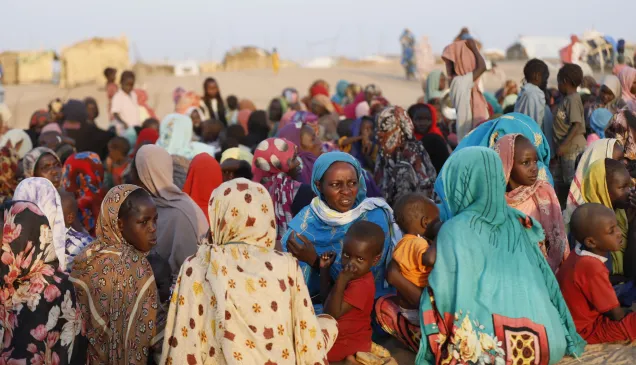Safe Access to Urban Services in Armed Conflict and Violence, Statement by Diane Misenga Kibeya, Deputy head of delegation of the ICRC to the African Union, 15th International Conference on Urban Health, Managing Urbanization for Health: A Priority for all Nations, Kampala 26-30 November 2018
In an urbanizing world, armed conflict and violence are urbanizing too.
Increasing numbers of people around the world are living through armed conflict in towns and cities, or experiencing chronic urban violence. This affects their health severely.
Armed conflicts are increasingly taking place in cities and towns. Urban space is fought over in ways not widely known for decades - since the Second World War and the wars in South East Asia.
The experience of cities like Mosul, Mogadishu, Aleppo, Juba, Bangui, Sirte and Hodeidah now typify contemporary urban warfare and its intense civilian suffering.
Today, I would like to set the scene of modern urban warfare and chronic urban violence. Then I would like to focus on three things:
- the impact of conflict and violence on health
- the ICRC's expanding humanitarian response in urban areas
- a call for greater respect of international humanitarian law (IHL) in urban armed conflict and the priority of safe access to resilient health services in armed conflict and urban violence.
War destroys and degrades urban life and space
Many urban communities in conflict today are forced to live under repeated bombardments from the air and from artillery. The use of explosive weapons with a wide area impact in densely populated areas is highly destructive of people, property, livelihoods and essential services.
Cities are often divided for months and years in stalemates between opposing forces. Battles to take and re-take towns and cities often leave much of them completely destroyed.
Millions of people have also experienced terrible conditions of life under protracted sieges or in "hard-to-reach" urban areas across Middle East wars, with their labyrinthine networks of checkpoints and frontlines that cross and confuse modern urban space.
Health care personnel, facilities, and transports as well as the wounded and sick are also frequently subject to acts of violence in conflicts today, very often in violation of the Geneva Conventions, so further degrading available health services.
The direct and indirect damage as well as gradual degradation of health services in conflict leads to situations like that in Yemen today where only 40% of the country's health services are functioning.
War creates new urban spaces
War destroys urban space but it also creates new urban spaces as people are forced to flee within and across State borders. This is because they have fled there from unsafe rural areas to swell population levels in cities like Mogadishu and Maiduguri, or because they have moved within a city to find relative safety as frontlines change.
Most of the world's internally displaced people (IDPs) now live in cities - many of them by staying with host families or by occupying abandoned and damaged buildings, construction sites or unbuilt ground. In the process they shape new informal settlements and slums.
Many others flee across borders to transform the urban space and demography of neighbouring or distant countries. In the Middle East, urban space in Lebanon and Jordan has been transformed by millions of Syrians. In Uganda and Ethiopia, new urban space and informal settlements have been created by millions of South Sudanese fleeing conflict in their country.
Displaced people are often changing cities and making new cities in weeks, without any of the planning and services to accompany managed urbanization or urban growth.
Urban Violence
In other towns and cities across the world, chronic urban violence rooted in organized crime and gangs is entrenched, often in extremely concerning conditions of high homicide rates and the creation of large "ungoverned" urban spaces where essential services in health and education are eroded at best and failed at worst.
Urban armed conflicts and the almost epidemic spread of chronic urban violence pose a humanitarian crisis of safety and security that often exposes millions of people in towns, cities and informal settlements to serious protection risks.
These protection risks can dramatically change people's levels of health and their access to health services.
The impact of conflict and violence on health
Armed conflict and violence are major determinants of health for people all around the world.
We in the ICRC see this effect in people's lives every day.
Conflict and violence cause ill-health directly by physical wounding, injury, sexual violence, or psycho-social stress which in turn may even result in mental health conditions.
Violence and conflict also lead indirectly to ill-health because of the spread of deprivation, impoverishment, displacement, destitution, hunger and disease they cause in people's lives.
People's health also deteriorates from conflict and violence because of the damage and gradual collapse of health services, and other essential systems and services that determine health like livelihoods, social protection, water systems and education.
Many of today's conflicts last for decades as "protracted conflicts" in countries across Africa, Europe and the Middle East, and urban violence also overshadows people's lives year after year especially in Latin America but also increasingly in Africa, Asia and Europe.
In a recent study on protracted conflict, the ICRC estimated that we have been operating in our top ten emergency operations for an average of 36 years.
This means that for many millions of people around the world, armed conflict is a multi-generational experience. Not surprisingly, its damage and duration has a deep and enduring impact on health and access to health services.
For hundreds of millions of people, conflict and violence are an entrenched and profoundly negative determinant of health.
The ICRC's expanding response in urban areas
The ICRC has dramatically expanded its urban response in the last 15 years. Our humanitarian operations have undergone "an urban revolution" as we respond to people's needs for protection, food, water, health, livelihoods and education in urban areas.
This sees us working across large and densely populated areas at a new scale – often supporting water and electricity supplies to millions of people across a country's urban areas. It also involves levels of technological sophistication and urban complexity unprecedented in our history as we work to ensure continuity and resilience in urban infrastructure of essentially middle income countries like Syria, Iraq and Ukraine.
To meet urban people's immediate health needs and to counter erosion in the positive determinants of their health, we engage simultaneously on protection, water, sanitation, livelihoods and education to achieve health impact.
Doing this well means working closely with all parties to conflict, relevant authorities responsible for essential services and with technical partners from national and municipal government, Red Cross and Red Crescent Societies and business contractors with the skills to ensure service continuity in electricity, health, water, sanitation infrastructure.
Our work always carries a strong preventive purpose. In Maiduguri - a city rapidly expanded by internal displacement - only 30% of people have access to clean water services. This is a major challenge to health which we are working to correct.
Working in towns and cities has also brought us into contact with the widespread challenges of non-communicable diseases (NCDs) and mental health and psycho-social support (MHPSS), in addition to the disease burden from infectious diseases.
These bring new operational dilemmas of health equity, and ICRC is re-shaping its health programming to a more holistic approach. We are expanding in community-based MHPSS services and strengthening our system of referrals for NCDs.
For example, in several cities, the ICRC ensures cold chain management for insulin and vaccines where the lack of electricity risks the safe delivery of medicines; and we strengthen health system resilience against the background of outbreaks and emergencies.
Safe access to healthcare remains a huge problem for people enduring urban warfare and urban violence. Safe movement and clear communication are critical here.
Often it is not safe to move freely in conflicted urban space and patients and health staff cannot reach health services, or fear to try. This is especially true if health services are perceived as being deliberately targeted by parties to conflict.
Knowledge about health services is another major break on access. A recent ICRC study found that people's knowledge of available services is the main gatekeeper to accessing healthcare. Communities often don't know about the health centre one block away, the nature of its services, who provides them, if they are eligible for them, and if they are free of charge. Communicating health service availability is a priority in contested urban space.
A call for greater respect for IHL
The rules of international humanitarian law (IHL) are clear about the need to protect the civilian population and to prioritize and protect health services for the wounded and sick, whether wounded and sick combatants or fighters or wounded and sick civilians.
In urban warfare today, the ICRC calls on all States and all parties to conflict to respect IHL. It also calls on all States supporting parties to conflict in various ways to ensure that their partners respect IHL. And we urge all parties to pay particular attention to the following three priorities:
- Stop and prevent attacks against healthcare – protect healthcare facilities, transport, personnel and patients from all forms of violence and attack.
- Avoid the use of explosive weapons with a wide impact area in densely populated areas, where they can bring about indiscriminate civilian harm and destroy, damage and disrupt critical infrastructure on which essential services depend.
- Actively support the continuity of resilient urban services on which civilian populations depend by facilitating the provision of relief and humanitarian action, and ensuring people's safe access to these services.
Although IHL does not apply to cities affected by chronic urban violence, the challenge of safe access to health services and other essential services that determine health – like water, electricity and education – are equal priorities in parts of towns and cities affected by chronic urban violence.
I hope I have shown how urban warfare and urban violence are major and negative determinants of health for many millions of people around the world. The vital humanitarian agenda to protect these people is clear and has been most recently recognized by States in the New Urban Agenda.
The importance of ensuring safe and effective health services in armed conflict and chronic urban violence – and the other essential services which determine people's health – is also essential if there is to be any chance of delivering on SDG 3 for the world's poorest people who live in fragile and conflict affect areas.
Thank you.
END



